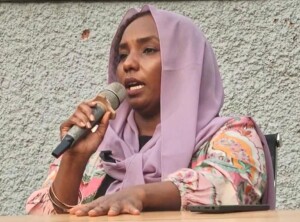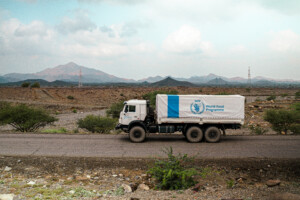‘Timely response to cholera outbreak saved many lives in Sudan’: OCHA
Cases of diphtheria, dengue fever, Rift Valley fever (RVF), chikungunya, and cholera continue to be reported across Sudan. As for the spread of cholera, the prompt response of the Sudanese Ministry of Health and partners have resulted in a much lower total caseload compared to the previous outbreak in 2016-2018, the UN Office for the Coordination of Humanitarian Affairs (OCHA) in Sudan stated in its Situation Report on Thursday.
 Cholera patients in Salemeen village in El Gedaref, July 8, 2017 (RD)
Cholera patients in Salemeen village in El Gedaref, July 8, 2017 (RD)
Cases of diphtheria, dengue fever, Rift Valley fever (RVF), chikungunya, and cholera continue to be reported across Sudan. As for the spread of cholera, the prompt response of the Sudanese Ministry of Health and partners have resulted in a much lower total caseload compared to the previous outbreak in 2016-2018, the UN Office for the Coordination of Humanitarian Affairs (OCHA) in Sudan stated in its Situation Report on Thursday.
As of 18 December, the Health Ministry reported 80 cases of diphtheria (including 12 deaths), 4,096 dengue fever cases (13 deaths), 453 Rift Valley fever cases (11 deaths), 260 cases of chikungunya (5 deaths), and 346 cholera cases (11 deaths).
This year, malaria breached the epidemic threshold, accounting for 12.4 per cent of all diseases surveyed by the health sector. This is a 30 per cent increase compared to the same period last year.
More than 1.8 million cases of malaria were reported so far in Sudan in 2019. The rise in malaria cases is closely related to the floods this year, which were heavier and longer than usual.
The widespread presence of stagnant floodwaters offers breeding grounds for mosquitoes—which transmit diseases such as malaria, yellow fever, and dengue.
Government authorities and humanitarian partners are actively responding to these outbreaks across the country, providing health assistance, vaccinations were appropriate, and vector control interventions, OCHA reported.
Cholera
On September 2, the Blue Nile state Ministry of Health reported five suspected cholera cases from El Roseires Hospital. The first case was detected on August 28.
On September 8, the Sudanese Ministry of Health declared a cholera outbreak in Blue Nile state after receiving positive laboratory results confirming the presence of Vibreo Cholerae in four out of six samples collected.
The response this year started as early as September 2. Nine days later, the World Health Organisation (WHO) and the Sudanese Health Ministry conducted the first joint health and water, sanitation and hygiene (WASH) cluster meeting on cholera response in Blue Nile state.
As of December 17, 346 suspected cholera cases (including 11 deaths) were reported from Blue Nile, Sennar, El Gezira and Khartoum states, according to the Sudanese Ministry of Health.
Early detection, timely intervention
During the second half of September, WHO experts visiting Sudan estimated that without proper and timely interventions, there could be between 5,000 and 13,200 cholera cases between September-February.
The projections were created based on the pattern of previous cholera/Acute Watery Diarrhoea outbreaks between 2016-2018, which can be characterised as the “delayed outbreak detection and response” case.
The information available and latest figures indicate that the prompt response and mitigation measures by all health sector partners led by the Health Ministry in Khartoum have resulted in a much lower total caseload and spread control, compared to the previous 2016-2018 outbreak, when about 37,000 cases were reported.
Half-way through this period forecast period, the reported number of cholera cases is way below the projected scenario that the WHO expert team developed.
This is attributed to the early detection, reporting, and early response and mitigation measures taken at the right time, including a three-month (October-December 2019) $20.3 million cholera readiness and response plan was developed, that included the first round of the oral cholera vaccination (OCV) campaign in eight high-risk localities in Blue Nile and Sennar states.

cholera (Sudanese Doctors' Committee, 2018)
Thousands of potential cholera cases were prevented, deaths were averted, and time and resources were saved, OCHA stated.
The data on cholera cases shows that the cholera outbreak has been on a downward trend. Since early November, 14 new cholera cases were recorded, with no new cases reported during a number of weeks.
‘Watery diarrhoea’
In August 2016, cases of suspected cholera were recorded in Blue Nile state. However, in spite of numerous independent confirmations (conducted according to WHO standards) that the disease was cholera, the Sudanese authorities and several international organisations persistently referred to it as ‘Acute Watery Diarrhoea’.
“It seems a stigma for the government,” UK-based epidemiologist Ezzeldin Gamar told Radio Dabanga on January 31, 2017. “We were not allowed to write about it [cholera] in our medical reports. He said he knew of doctors who were transferred or never hired again, after they diagnosed cases as cholera.
Doctors of Sudan’s National Epidemiological Corporation reported in July 2018 that nearly 24,000 Sudanese had been infected and 940 cholera patients died. The WHO and the Sudanese Ministry of Health reported in mid-October that year that the total number of recorded cases reached more than 35,000 people – including 800 related deaths.
Follow #CholeraInSudan, #ألكوليرا_السودان
Radio Dabanga’s editorial independence means that we can continue to provide factual updates about political developments to Sudanese and international actors, educate people about how to avoid outbreaks of infectious diseases, and provide a window to the world for those in all corners of Sudan. Support Radio Dabanga for as little as €2.50, the equivalent of a cup of coffee.












 and then
and then